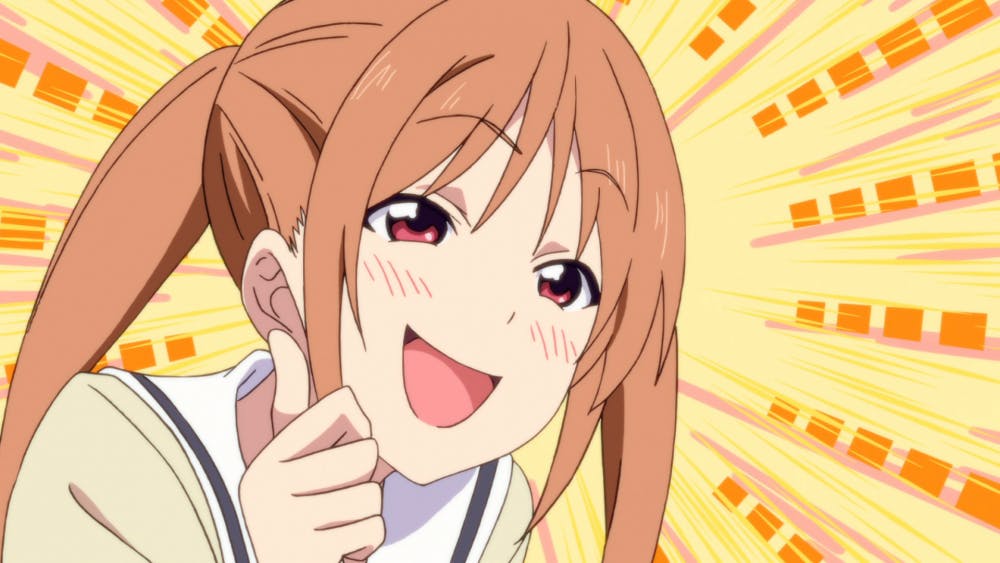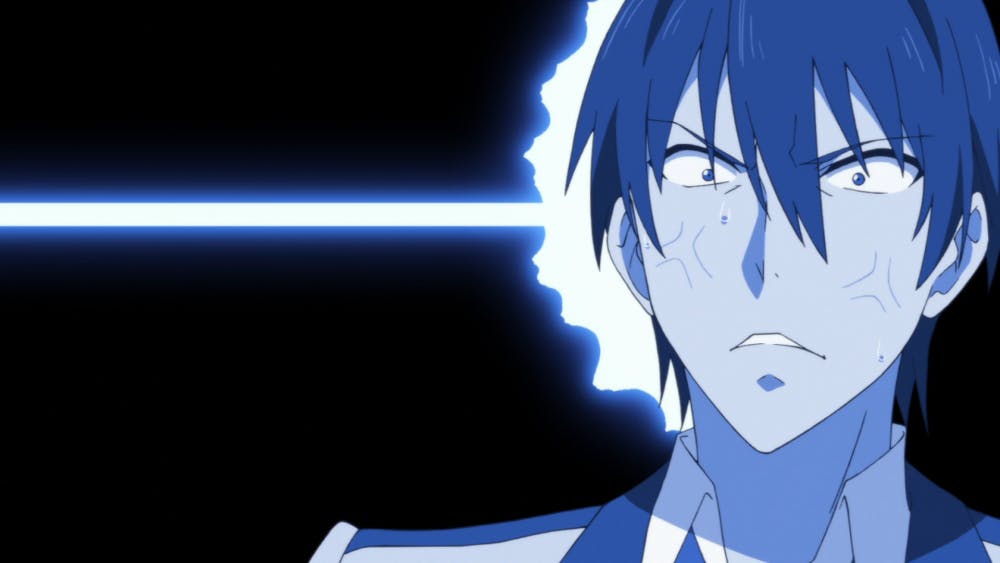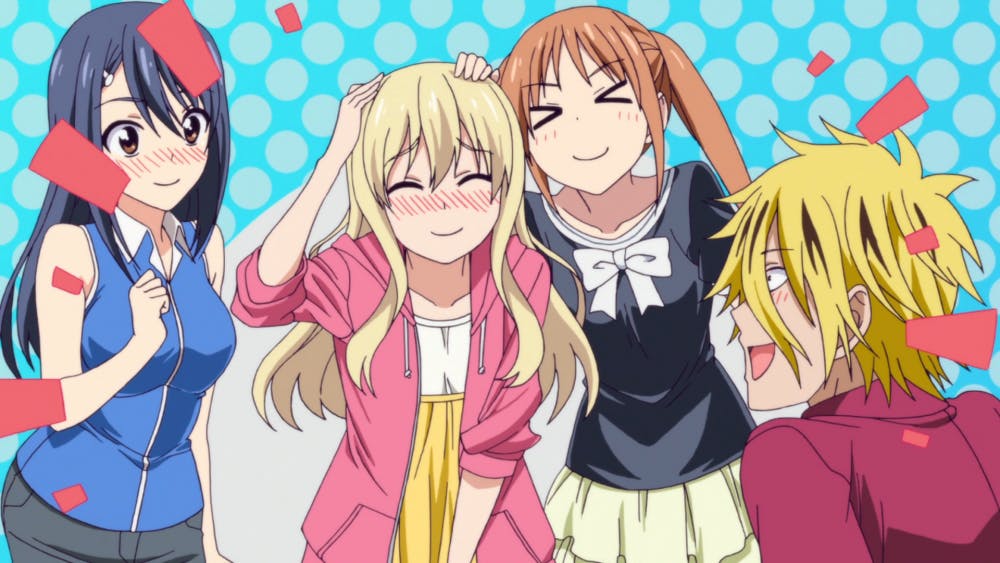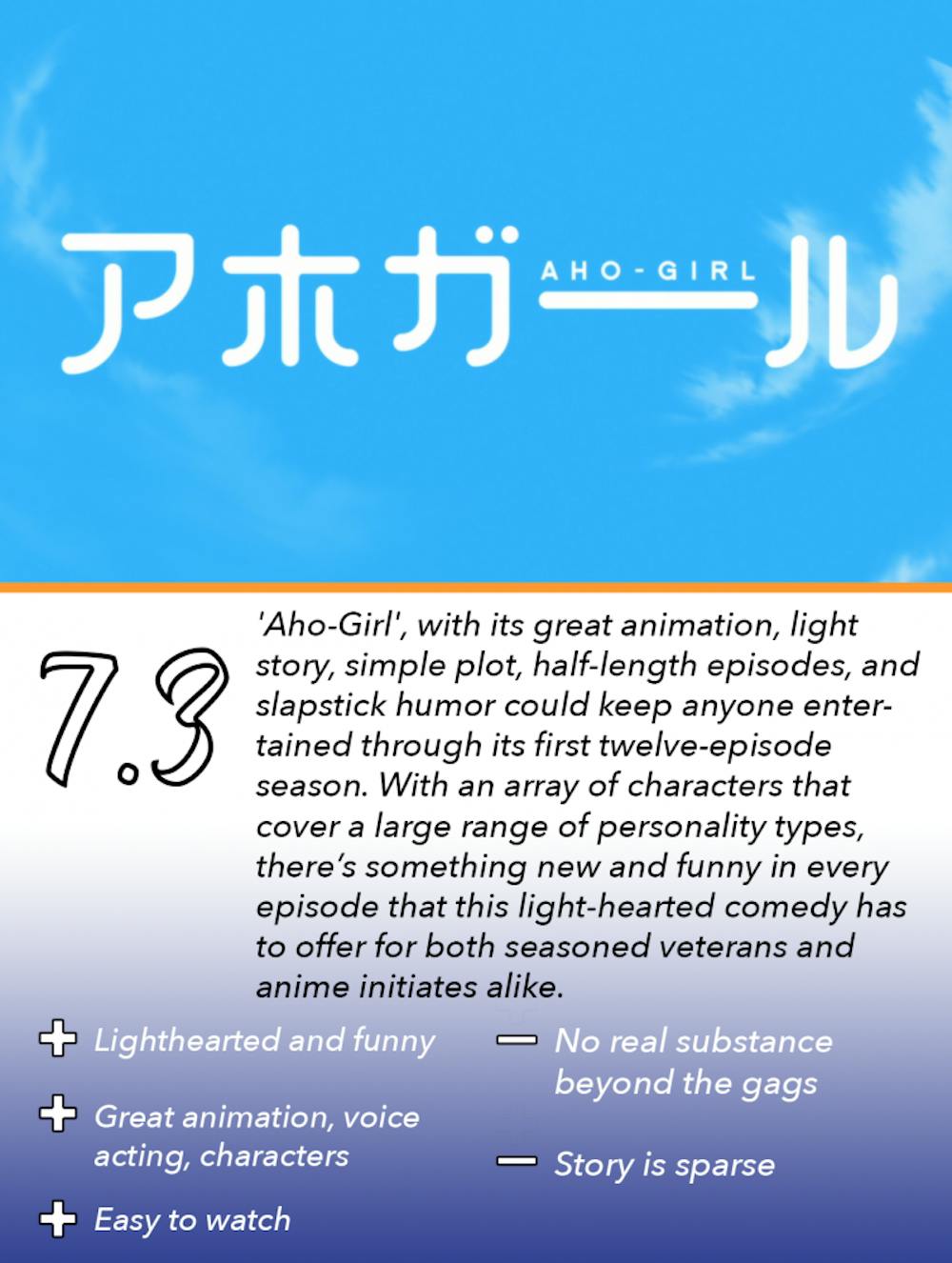From the moment the upbeat opening song starts, with its variations of pop, big band, and opera themes, one can instantly tell that this show isn’t here to be taken seriously. Even the name of the show, Aho-Girl, is as blunt as it gets, translating into something in the realm of Stupid-Girl. But when an unnamed character walks on screen, begins eating a banana, and is showered by shooting stars in the shape of bananas, the tongue-in-cheek nature becomes even more apparent. All the ridiculousness aside, Aho-Girl is an oasis of light-hearted fun that is accessible to anyone with its slapstick humor, light story, and small time investment. Aho-Girl is very easy to digest and, if you don’t mind contracting small fits of laughter, can be very enjoyable for seasoned veterans and anime initiates alike.
No story, no problem
Aho-Girl is a half-length comedy anime series which follows the life of Yoshiko Hanabatake, along with her childhood friend Akuru Akutsu, to see what antics this comedic duo can get into. Our main character, Yoshiko, is a lively high school student who consistently gets zeroes on multiple choice exams, is highly obsessed with bananas, has little self control, and is very perverse. However, Akuru Akutsu, who is commonly referred to as A-kun, is a typical straight-laced student who is studious, cold-hearted, blunt, and short tempered. Along the way, the viewers get introduced to a small cast of secondary characters that bring plenty of variety to the show with characters from kids to delinquents.

When it comes to the plot in Aho-Girl, there really isn’t anything to write home about. The plot is based around following Yoshiko around in her daily life as she gets into situations that are funny and entertaining. With the plot being so simple, there is basically no need to give the viewer much if any introduction to Aho-Girl. The show starts with Yoshiko showing A-kun how she got zeroes on all her proficiency exams, which causes A-kun to reply with how big of a dunce she is. What’s surprising is that this is the only backstory that’s given about these characters in the first episode. It takes no time to get into the meat of the show as it quite literally throws the viewer into the deep end of the pool immediately after the first sixteen-second exchange between Yoshiko and A-kun.
As far as story goes for Aho-Girl, it is very sparse since the show mostly focuses on telling a good joke than having a compelling traditional story. Aho-Girl follows a very similar formula to that of Nichijou. They both lack a traditional story but instead decide to tell small condensed stories that can be finished in a relatively short amount of time. This means that Aho-Girl doesn’t really have an overarching plot, it’s more like a collection of small skits that are related to each other because of the characters that are involved, not a show-length narrative. And because the show is structure around small isolated skits, the quality of each one can vary from engaging to mediocre.
This is where the origins of Aho-Girl are really apparent. With most of the material for the show coming from a series of four panel comics, the skits are pretty much over as soon as they start. This makes the show a little harder to watch because if you aren’t invested in the comedy or the characters, there isn’t much else this show can offer. All of this adds up to a story that is all but replaced with short skits that can make it harder for those that look for anime with a more concrete structure and longer lasting appeal. However, it is very easy to forgive Aho-Girl for its lackluster story because of the inherent difficulty in developing a great story with half the runtime a normal 24-minute anime would have while maintaining the shows’ overall goal of being funny.
Triumphing with tropes
The main characters, Yoshiko and A-kun, are pretty standard for a show of this category. They have a yin-yang dynamic where they are stronger and more impactful together than when they are apart. This type of duo is so common that it has its own identifying phrase in Japan, called the boke and tsukkomi routine. The comedy in the show revolves around the fact that Yoshiko, the boke character, makes a lot of really misconstrued statements that are swiftly met with A-kun, the tsukkomi character’s attempts to fix Yoshiko’s misconceptions until he eventually snaps and uses overly exaggerated violence to subdue Yoshiko temporarily.
The trope that these two fall in is very effective at both defining how these characters would think and act in certain situations. Even though these characters follow specific tropes, they have interaction with the other characters that are both enjoyable and offer a significant amount of variety. For example, Yoshiko has so little self-restraint that when she interacts with any of the other characters, the absurdity of what she says or does alone is enough to coax a laugh out of the viewer.

Another strength that is very apparent with this anime is the variety of its characters. The characters range from the moe shy girl to lewd class president, filling the roster of side characters with a wide range of personality types. But, just like the two main characters, all of the side characters follow a specific trope that can be easily identified by anyone, even anime novices.
Even though the use of tropes is considered lazy writing, the difference between Aho-Girl and many other shows in the same category is that the tropes of each character are used effectively within the context of the show. The writers use each character’s originality to create a more interesting show by introducing different types of comedy based on which characters are on screen. The writers even go as far as to create conflicts between the side characters for that extra bit of variety that these types of shows thrive on. This element means that the show can branch away from the main characters and focus on these conflicts between the less prominent characters that, while they don’t follow the formula that is present in interactions between Yoshiko and A-kun, are interesting and funny in their own right.
With so many options for characters at the show’s disposal, each skit that is presented to the viewer is unique and interesting. The character diversity in Aho-Girl and its effective use is very commendable as it increases the overall enjoyment viewers can take out of it. In every episode, viewers can enjoy unique and interesting dialogue that will have them contracting the “one more episode” bug that this bite-sized anime is so effective at spreading.
Giving the characters life
Aho-Girl art is very typical for a modern anime, but that doesn’t mean that it’s mediocre. The characters are detailed enough to be impressive, and even characters that are a decent distance away have enough detail for the viewers to see that a lot of work went into hand drawing all the characters. The default style is what many would consider a modern anime style that isn’t overly cute because the proportions are more realistic and less overly exaggerated. But, as a side note, the hands are on point. Even the backgrounds have an extraordinary amount of detail.
But, this wouldn’t be a comedy anime without sudden changes in art style. An example of this is when a character is shocked with disgust, they’re drawn only in black and white with their eyes covered in a dark shadow. Aho-Girl exploits these types of art style changes masterfully to make funny moments funnier and convey the emotions of the characters on screen. Besides having a pretty normal art style for an anime when nothing special is going on, the show likes to throw curveballs by changing it up for some of the skits. Overall the art is consistently great without any major pitfalls, which makes Aho-Girl very easy to watch and enjoy.
The animation plays a crucial part in Aho-Girl’s impact. With every punch that is given, twirl that is done, or subtle change in facial expression, more life is given rather than taken from the characters. The rate at which characters change from pose to pose is very quick and natural which means that Aho-Girl has been animated very thoroughly. The animation of characters’ faces when they’re close to the screen exemplify the quality of the painstakingly detailed animation in Aho-Girl.

A good example of the attention to detail is the first exchange between Yoshiko and A-kun in the first episode after the intro. Small details such as the shadows on A-kun and his book as he shifts to look at Yoshiko, the shadows changing on Yoshiko’s proficiency exams as they’re waved around, Yoshiko’s hair as it lowers from her moving up and down while she talks, showcase all the hard work that went into animating Aho-Girl. Even when things get more hectic and people are flying across the screen after getting punched, the animation remains smooth and polished. Anyone can see that, without a shadow of a doubt, the animation is great, which is really surprising as this is a half-length anime coming from a four-panel comic.
The voice acting checks all the boxes that are needed for a comedy anime. The range of emotion, believability, and overall execution is excellent. There is never a time where the voice acting and the character feel separate from each other, which is a telltale sign of how polished Aho-Girl is. All the emotions of the characters on screen are conveyed naturally in the voice acting, it never sounds artificial. The voice given to each character fits very well with their designs. Yoshiko sounds more childlike and upbeat but A-kun sounds more serious and composed, when he isn’t angry. With that, Aho-Girl passes each of the quality tests to present an incredible anime, and with flying colors too.

Featured image from Crunchyroll
For more entertainment related content, visit us at Byte Bsu!




















